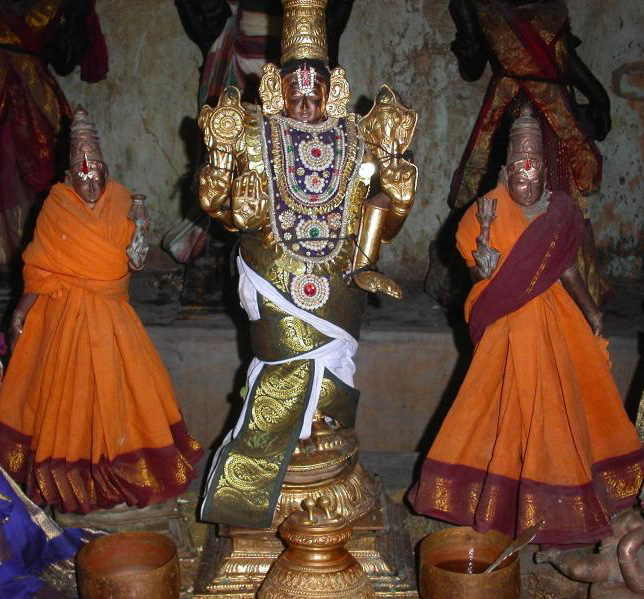![[thirunangur.jpg]](http://bp1.blogger.com/_L8rvmoscD8o/RkBFIPnPmdI/AAAAAAAAAPE/k8kONfa3DGo/s1600/thirunangur.jpg)
This dhivyadesam is situated at Keezha chaalai village about 3 km towards north-west from Thiru Nangur. This temple is also called as "Maadhava Perumal Koil" in locality.
| Thiru Thevanar Thogai | ||
| Sl.No | Name | |
| 1 | Moolavar | Theivanayaka Perumal, Facing west direction, Standing posture |
| 2 | Uthsavar | Madhava Perumal |
| 3 | Thayar | Kadalmagal Naachiyar, Madhava nayaki |
| 4 | Theertham | Shobana Pushkarini |
| 5 | Vimanam | Shobana Vimaanam |
| 6 | Mangalasasanam | Thirumangai Azhwar |
The Lord is in standing pose, while the Thayar is in sitting pose. The Lord graces with Four arms, the Upper arms holding discus and conch and the Lower right arm is in Abhaya mudra and lower left arm is holding the mace. Madhava implies it is related to Thayar. 'Ma' means Sri Maha Lakshmi Thayar; and 'dhava' means Leader. So, Madhava means the Husband of Thayar. This is different from carrying Thayar on chest, when He is called Sridhara. Thayar here is called Sri Madhavanayaki; that is Wife of Madhava, Who is Husband of Sri MahaLakshmi. Thus it proves that both are interdependent in this Divine Couple. In the Milk ocean churning episode the Lord churned the ocean with thousands of His hands. Swami Koorathalwan says that in that process many things came out of the ocean, but Sri Thayar emerging out of the ocean, straight away went and garlanded the Lord and at that time the Lord became Sri Madhava. Worshiping Her and with Her recommendation, we should seek refuge at the Feet of the Lord; and this will be to the liking of Sri Krishna. Therefore, Sri Krishna ridicules those who seek Swarga lok, and show more interest in the Poorva bhag [earlier part] of Vedas, also known as Karma kanda, which prescribe the procedures and objectives of various yagnas, like Jyothish homa, etc., and leave out Vedantha or Upanishads in the latter part of Vedas, also known as Gyana kanda. These persons are not true devotees of the Lord and will never reach Him. Arjuna wanted to know what was wrong in seeking those results? In reply, sloka 21 was told by Sri Krishna:
te tam bhuktva svarga-lokam visalam
ksine punye martya-lokam vishanti
evam trayi-dharmam anuprapanna
gatagatam kama-kama labhante
"When they have thus enjoyed vast heavenly sense pleasure and the results of their pious activities are exhausted, they return to this mortal planet again. Thus those who seek sense enjoyment by adhering to the principles of the three Vedas achieve only repeated birth and death."
Normally, slokas in Gita have 16 letters [aksharam] per line and 32 in one sloka. This is called anushtup chandas [metre]. But this, 20 and 22nd slokas have excess letters. Here, each line has 22 letters and 44 per sloka. Te =they, tam =such, bhuktava = pleasure is experienced, visalam = vast, svarga loke = heavens. Here, 'they' implies those who perform jyotish homa, etc., and seek heaven. Heaven is very large place with all pleasures and enjoying dances of beautiful apsaras women like Rambha, Menaka, Oorvasi, etc, Unlike the pleasures and sorrows alternating in this world, there, in heaven, happiness alone is there. Even if pleasure spots are available here, we are not equipped with that type of stamina or strength to continuously enjoy. But in swarga lok, the person going there is provided with heavenly body to enjoy continuously. Can they remain in swarga lok for ever? No. Ksine punye = all punya get reduced [as the pleasures of swarga lok are enjoyed and as time passes], martya lokam = the world of mortals or human beings, vishanti = return. By doing punya, the person reaches swarga lok or heaven and enjoys; but as time passes, the punya stock gets expended and gets reduced. Once reduced to a low level, he has to necessarily be born in this world of mortals. It is therefore, told that even a person in swarga would be in constant fear of returning back to samsaram. Can anyone enjoy with full satisfaction, if this constant fear is there? In fact, he would be facing naraka lok [hell] experience in swarga. And, he might think that instead of this, remaining in the world of mortals would have been better. Why, then seek heaven? We should note the word 'ksine' -reducing. It is not completely exhausted, but with a particular low level reached, they are reborn in this earth. Evam = thus, anuprapanna = following, trayi dharmam = three Vedas. In the last sloka the Lord told that these persons concentrate on the three Vedas' meanings. Such persons labhante = attain, kama kama = desired places and desired pleasures. Are these permanent? Ghata aghatam = they go [to heaven to enjoy] and return [to suffer in this samsaram]. He with a short sight enjoys this temporary happiness, only to come back again and grope in this samsaram. By concentrating only on the superficial meanings of the three vedas, these persons get what they want to enjoy in heaven; but they never realize the inferior and transient nature of this happiness. They little realize that Sri Krishna is the everlasting happiness and Vaikuntam is the place from where there is no return to samsaram. Upanishads emphasise this. We now take leave of this Kshetram.

No comments:
Post a Comment